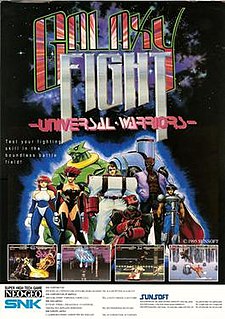
Galaxy Fight: Universal Warriors is a fighting game originally developed and published by Sunsoft in 1995 for the Neo-Geo MVS in arcades, and then for the Neo Geo AES console. It was Sunsoft's second fighting game after their 1994 Super Famicom spin-off of their Hebereke series, Sugoi Hebereke, as well as their first side-viewed 2D fighting game.

World Heroes Perfect is a 1995 fighting arcade game developed and published by ADK with the assistance of SNK. It was originally released for the Neo Geo MVS arcade cabinet on May 25, 1995. It is the fourth and final title of the World Heroes series.
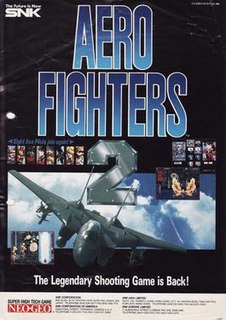
Aero Fighters 2 is a vertical-scrolling shoot 'em up arcade game released in 1994 by Video System. It is developed by SNK and released in Japan, North America and Europe. It is the second part of the Aero Fighters series followed by the third part Aero Fighters 3 and a spin-off Aero Fighters Assault. It was initially released as a cabinet token base game.
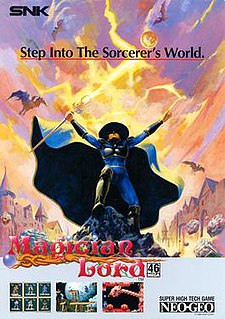
Magician Lord is a side-scrolling action-platform arcade video game developed by Alpha Denshi and originally published by SNK on April 26, 1990. It was one of the launch titles for both the Neo Geo MVS (arcade) and Neo Geo AES (home) platforms, in addition of also being one of the pack-in games for the AES.

Baseball Stars Professional is a baseball arcade video game developed and originally published by SNK on 26 April 1990. A follow-up to the original Baseball Stars on Nintendo Entertainment System, it was one of the launch titles for both the Neo Geo MVS (arcade) and Neo Geo AES (home) platforms, in addition of also being one of the pack-in games for the AES, as well as the first baseball title released for the Neo Geo.
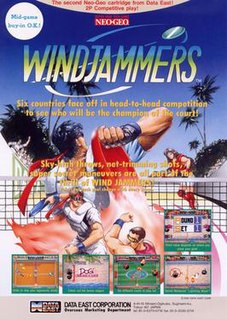
Windjammers is a sports arcade game released by Data East on the Neo Geo arcade system in 1994. The game mechanics are essentially the same as Pong or air hockey, where players continuously shoot the disc at the goal zone of the opponent attempting to score. The game can be played against the computer or in a 2 player versus. Dotemu ported the game to PlayStation 4 and PlayStation Vita in August 2017, Nintendo Switch in October 2018, and iiRcade in February 2021. Dotemu would later develop and publish a sequel, Windjammers 2, which was released on PlayStation 4, Xbox One, Nintendo Switch, PC and Google Stadia on January 20, 2022.

Pulstar is a 1995 horizontal-scrolling shooter arcade game published by SNK. Players control a starship in its mission to eradicate the Solar System of a hostile race of aliens that threaten mankind. Its gameplay has been compared to the R-Type series for its similar premise and mechanics; players must complete each of the game's eight stages by destroying constantly-moving formations of enemies and avoiding their projectiles. There are power-ups that can be collected that provide additional abilities for the player. It runs on the Neo Geo MVS arcade system board.

Burning Fight is a beat 'em up arcade game released by SNK in 1991 for the Neo Geo MVS system. Introduced to capture a share in the then-popular beat 'em ups market, it was meant to compete with Technōs' Double Dragon, the leader of the genre at the time. Three years after its release in the arcades and on the Neo Geo AES, it was released on Neo Geo CD as the only other home version.

Blue's Journey is a side-scrolling platform game released by Alpha Denshi in 1990 on SNK's Neo Geo MVS arcade system and their AES home system. It was ported to the Neo Geo CD in 1994. It was rereleased on the Wii's Virtual Console in Europe on November 9, 2007, followed by North America on November 12, 2007.

Top Hunter: Roddy & Cathy is a side scrolling arcade beat 'em up platform game developed by SNK for the Neo Geo in 1994. It was also released on the Neo Geo CD, and the Wii Virtual Console. The game has been re-released as part of SNK Arcade Classics Vol. 1, on May 1, 2008, and in the ACA Neo Geo series on PlayStation 4 on January 10, 2018. Its development team consisted of former Irem staff members.

Spinmaster is an arcade game developed and released by Data East in December, 1993 in North America, in Europe the same year and on February 18, 1994 in Japan. It is the first game Data East developed and released for the SNK Neo-Geo MVS hardware. Its character designs are almost identical to the ones in Data East's Sega Genesis game titled Dashin' Desperadoes; however, the rest of both games are completely different. Also, Spinmaster's gameplay, artwork style, animations of some characters and the styles of its weapons were heavily inspired by another arcade game by Data East titled Joe & Mac, according to the Japanese Miracle Adventure arcade flyer.
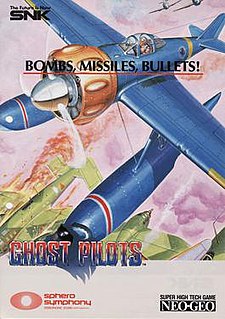
Ghost Pilots is a vertically scrolling shoot 'em up arcade game released in 1991 by SNK. The gameplay is straightforward with elements similar to that of Capcom's 194X games. Unlike most scrolling shooters, the vehicle is a seaplane instead of a spaceship or airplane.

Sengoku 2 is a beat 'em up arcade game. It is the second game of the Sengoku series by SNK. It was ported to the Neo Geo and Neo Geo CD consoles. In 2009 the series was compiled on a CD titled Sengoku Anthology for the PlayStation 2 and Windows. The Neo Geo version was re-released on the Japanese Virtual Console in November 8, 2012 and for the PAL region on February 7, 2013. In 2017, the game was re-released as part of the ACA Neo Geo series for the Xbox One, followed by the PlayStation 4, and also on the Nintendo Switch and Windows 10 via Steam the following year.
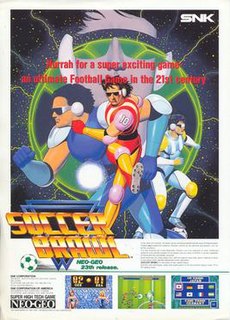
Soccer Brawl is a futuristic soccer game first released in arcades on February 14, 1992. It was available on the Neo Geo on March 13 the same year and later for the Neo Geo CD on March 31, 1995.

Puzzled is a falling-block puzzle video game developed and published by SNK that was released for Neo Geo arcades in 1990, on the Neo Geo home console in 1991, and the Neo Geo CD in 1994. The game was ported to mobile phones in 2005, then was re-published by D4 Enterprise on the Wii Virtual Console in June 2011, and it is also one of the twenty games that came pre-loaded on the Neo Geo X console released in 2012. It was also ported in August 2017 to Nintendo Switch, Xbox One and PlayStation 4 as part of Hamster Corporation's ACA Neo Geo series.
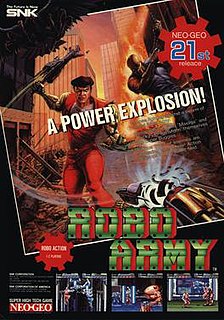
Robo Army is a beat 'em up video game developed and published by SNK that was released for Neo Geo arcades and home consoles in 1991 and the Neo Geo CD in 1995.

Power Spikes II is a volleyball arcade video game developed by Video System and originally published by Taito on October 19, 1994. A follow-up to Hyper V-Ball on Super Nintendo Entertainment System, it was first launched for Neo Geo MVS (arcade) and later ported to Neo Geo CD. It is the final installment in the Super Volleyball series. It is also the only volleyball game released on the Neo Geo.

Super Sidekicks is a 1992 soccer arcade video game developed and published by SNK. It is the first installment in the eponymous series and the second soccer game released for Neo Geo MVS, succeeding Soccer Brawl (1991). Featuring an arcade-style approach to soccer compared to other games released at the time, the title allows players to choose any of the available game modes with AI-controlled opponents or other human players with the team of their choosing. Its gameplay uses a simplified two-button configuration.
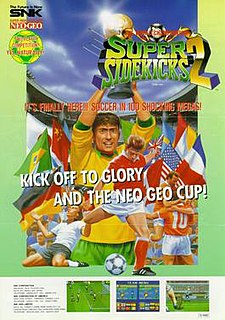
Super Sidekicks 2: The World Championship is a 1994 soccer arcade video game developed and published by SNK. It is the second installment in the Super Sidekicks series and the third soccer game released for Neo Geo MVS, preceding the original Super Sidekicks (1992). Featuring an arcade-style approach to soccer as its predecessor, the game allows players to choose any of the available game modes with AI-controlled opponents or other human players with the team of their choosing. Its gameplay uses a simplified three-button configuration.

Super Sidekicks 3: The Next Glory is a 1995 soccer arcade video game developed and published by SNK. It is the third installment in the Super Sidekicks series, preceding the original Super Sidekicks 2: The World Championship (1994). Featuring an arcade-style approach to soccer like its predecessors, the game allows players to choose any of the available game modes to compete with AI-controlled rivals or other human players with their preferred team. Though first launched for the MVS hardware, the title was ported for Neo Geo AES and Neo Geo CD, in addition of being re-released through compilations and download services for various consoles. It proved popular among players and garnered positive reception from critics, however most reviewers noted that it felt as an update than a true successor to Super Sidekicks 2. It was followed by The Ultimate 11: SNK Football Championship in 1996.





















